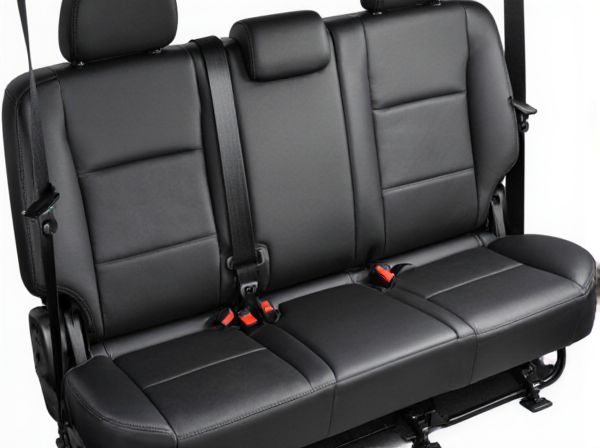
Photo illustration: Bucket-Style Rear Seat vs Traditional Rear Bench
Bucket-style rear seats provide enhanced comfort and individual support compared to traditional rear bench seats, which often prioritize accommodating more passengers. You will find bucket seats ideal for long journeys or rides requiring better posture and reduced fatigue. Their contoured design also offers a sportier appearance, while traditional benches deliver simplicity and maximum seating capacity.
Table of Comparison
| Feature | Bucket-Style Rear Seat | Traditional Rear Bench |
|---|---|---|
| Design | Individual contoured seats for each passenger | Single continuous seat spanning rear cabin |
| Comfort | Enhanced ergonomic support, better lateral hold | Basic cushioning, less personalized support |
| Seating Capacity | Typically 2 passengers | Usually fits 3 passengers |
| Space Utilization | Optimized for individual seating, increased footroom | Maximizes overall seating space |
| Safety | Built-in headrests, often with integrated seat belts | Standard headrests, seat belts may be separate |
| Style | Sporty, premium appearance | Classic, practical look |
| Cost | Higher price due to design complexity | Generally more affordable |
Introduction to Rear Seat Configurations
Rear seat configurations in vehicles typically include bucket-style rear seats and traditional rear benches, each offering distinct advantages in comfort and functionality. Bucket-style rear seats provide individualized seating with contoured support, enhancing passenger comfort and often incorporating features like armrests and cup holders. Traditional rear bench seats maximize seating capacity by accommodating three passengers side-by-side, making them ideal for families and larger groups.
Defining Bucket-Style Rear Seats
Bucket-style rear seats are individual seating units designed to offer enhanced comfort, support, and contouring compared to traditional rear bench seats, which span the width of the vehicle and accommodate multiple passengers in a flat, continuous cushion. These seats feature distinct contours, bolstered sides, and separated cushions that provide ergonomic support and reduce passenger movement during driving maneuvers. Commonly found in luxury and performance vehicles, bucket-style rear seats improve overall passenger experience by combining style with functional seating ergonomics.
Understanding Traditional Rear Bench Seats
Traditional rear bench seats offer continuous seating space designed to accommodate three passengers with a single cushion and backrest, enhancing overall passenger capacity. These seats typically feature a flat and uniform surface, maximizing usable width and enabling easier installation of car seat anchors and seat belts for child safety. Their straightforward design reduces manufacturing complexity and cost, making them a common choice in many mainstream vehicle models.
Comfort and Ergonomics Comparison
Bucket-style rear seats offer enhanced comfort by providing individual seating contours that support the natural curve of the spine, reducing fatigue during long drives. Ergonomically, these seats include adjustable features such as lumbar support and side bolsters, promoting better posture and lateral stability compared to traditional rear bench seats. In contrast, traditional rear bench seats prioritize maximizing passenger capacity but often lack personalized ergonomic support, potentially compromising long-term comfort for rear-seat occupants.
Passenger Capacity Differences
Bucket-style rear seats typically accommodate two passengers, offering individualized seating with enhanced comfort and support, whereas traditional rear bench seats can fit three passengers, maximizing passenger capacity. The choice between these seating styles influences vehicle occupancy, with bucket seats often found in luxury or sports cars prioritizing comfort, and benches common in family or economy vehicles focusing on practicality. Passenger capacity differences directly impact vehicle usability, determining suitability for larger families or groups.
Storage and Practicality Considerations
Bucket-style rear seats offer individualized seating with built-in storage compartments and enhanced accessibility, making them ideal for organizing smaller items and providing separate storage solutions. Traditional rear bench seats maximize overall seating capacity but often lack dedicated storage spaces, requiring additional accessories like under-seat bins or organizers for practicality. Choosing between these designs depends on the balance between passenger capacity and the need for integrated storage features.
Impact on Interior Design and Aesthetics
Bucket-style rear seats enhance interior design by providing a more sculpted, sporty appearance and improved individual comfort, creating a premium feel often associated with luxury vehicles. Traditional rear benches offer a classic, cohesive look that maximizes seating capacity and fosters a sense of spaciousness, appealing to families and practical users. The choice between these two styles significantly influences the vehicle's ambiance, with bucket seats emphasizing modern aesthetics and ergonomics, while bench seats maintain timeless simplicity and utility.
Safety Features and Restraint Systems
Bucket-style rear seats enhance passenger safety by offering individual contours that reduce lateral movement in collisions, paired with integrated side bolsters for improved support. Traditional rear bench seats typically utilize standard three-point seat belts and may lack specialized restraint systems found in bucket designs, potentially increasing injury risk during impacts. Advanced restraint systems in bucket-style seats often include built-in pretensioners and load limiters, optimizing occupant protection by distributing crash forces more effectively.
Cost Implications and Market Availability
Bucket-style rear seats typically increase vehicle production costs due to their complex design and additional materials, often leading to higher retail prices compared to traditional rear bench seats. Market availability favors traditional rear benches in most entry-level and mid-range vehicles because of their cost efficiency and simpler manufacturing process. Luxury and performance models are more likely to feature bucket-style rear seats, reflecting a niche market where higher costs align with enhanced comfort and style preferences.
Choosing the Right Rear Seat for Your Needs
Bucket-style rear seats offer enhanced individual comfort and support, making them ideal for passengers who prioritize personal space and ergonomic design. Traditional rear bench seats maximize seating capacity and provide a uniform surface, suited for families or those needing flexibility in passenger and cargo arrangements. Selecting the right rear seat depends on prioritizing comfort versus seating volume, with bucket seats enhancing luxury appeal while bench seats optimize practicality and passenger accommodation.
 caratoz.com
caratoz.com